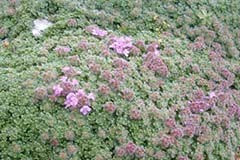
Thymus vulgaris
Culinary thyme; we use this around the garden as a summer flowering ground cover together with Thymus "Minimus". Great around rocks, in the herb garden or in the border.


Woolly thyme, useful as a lawn thyme or amongst stones in a rockery or gravel garden. Tight compact habit and pink flowers. Dry tolerant.
Woolly thyme, useful as a lawn thyme or amongst stones in a rockery or gravel garden. Tight compact habit and pink flowers. Dry tolerant.
Data sheet
Culinary thyme; we use this around the garden as a summer flowering ground cover together with Thymus "Minimus". Great around rocks, in the herb garden or in the border.
Spectacular plant native to the Canary Islands with outrageously huge purple flower panicles to 250 cm from a large rosette of foliage. Impress your neighbours and plant a hedge of these! They will occasionally re-seed.
A softer apricot colour than the regular brighter tangerine variety, flowers for much of the year in fertile heavier soil types.
Improved form with wider leaf blades than the species and larger inflorescence. A beautiful plant for larger spaces.
Richly coloured summer flowering achillea, begins as a deep burnt orange colour and will fade to a soft ochre.
This variety has huge, fringed orange-red blooms, which rival paeonies for show and splendour! Only a few, available July onwards.
A nice variation of Campanula latiloba with lilac flowers and upright flower spikes, showy but can be very spreading.
One of the tightest rosette forming varieties with blue-grey leaves and deep crimson tips. Plant in pots or between rocks.
Traditional white mop top Hydrangea, flowers do not discolour with pH variation, plants form a good low hedge or border in shady conditions.
Semi prostrate medium blue form with cascading habit, useful winter flowering ground cover.
Early summer flowering perennial for border and rock garden, ideal with dianthus, scleranthus and other cushion forming plants. White flowers.
The best white persicaria we have tried, as with Taurus and others, these will flower in summer but good much and soil fertility will ensure their best performance. Waist high or fraction higher in moister conditions, basal foliage with drifts of vertical white spikes. We like to plant these in clumped groups of 5 or 9 at 25cm spacings for best effect.
Native grassland species from Natal, dwarf and florific with violet purple flowers earlier than most other varieties.
Strong landscaping variety with bushy growth ideal for mass planting or hedges. Blue flowers in summer and drought tolerant once established.
Lovely white form of the normally purple species.This campanula doesn"t like too much winter wet or shade.
Bold foliage plant for moist areas with exotic foliage, native to Myanmar and Tibet. Extremely cold hardy, best grown along with other moisture loving plants on a pond margin or in part shade woodland environment. Associates well with filipendulas, astilbes, gunneras and primulas.

Woolly thyme, useful as a lawn thyme or amongst stones in a rockery or gravel garden. Tight compact habit and pink flowers. Dry tolerant.